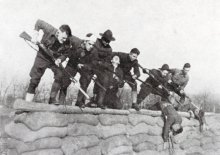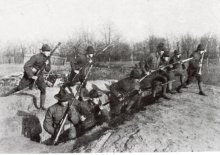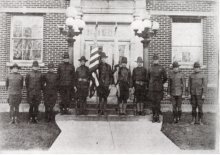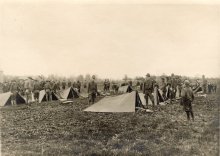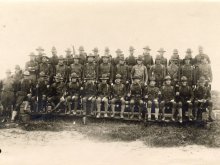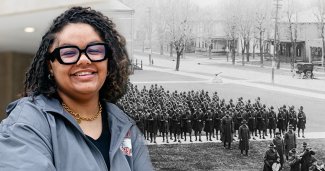
More than a century ago—July 28, 1914, World War I erupted in Europe.
Almost three years later, in April 1917, the United States entered the war to defend democracy, sending its sons and daughters to Europe’s battlefields.
Among their ranks were several Ohio Northern University students and alumni.
Last semester, ONU students in an upper-level history course taught by Dr. David Strittmatter, assistant professor of history, brought the stories of these ONU veterans of the Great War, long forgotten with time, into the light.
“It’s sometimes difficult for me to believe that the faces that stare at me from historical photos were real individuals,” said Naje Wright, senior criminal justice major.
Through her research, she came to realize the black and white images in the ONU yearbook were students not so different from her, who got swept up in a global event that shaped the course of history.
And unfortunately, she discovered it didn’t end well for most.
The Great War leaves its mark
ONU’s World War I course, which is offered every other spring semester, provides an overview of what Strittmatter calls “a watershed event in geopolitical history.”
When the Great War concluded with an armistice between the Allied powers and Germany on Nov. 11, 1918—a date now celebrated in the U.S. as Veterans Day—the world and even ONU’s campus, were changed in significant ways.
Europe’s map was reshaped, women earned the right to vote in the U.S. and many other countries, and the U.S. emerged as a major global player, explained Strittmatter.
“The United States had the largest industrial capacity in the world at the time, but it had never been tested on the European stage. After the war, it was just accepted by European countries that the young nation across the Atlantic was a power player and wasn’t going anywhere.”
While casualty rates in the U.S. weren’t as high as they had been in the Civil War, many young Americans perished in battle or from illness. Death rates in some European countries were staggering, said Strittmatter. France and Germany, for example, lost roughly 4 percent of their population.
The Great War also introduced chemical warfare and long-range artillery. The death, destruction, and horrors, left lasting scars and a sense of disillusionment.
This battle-weariness trickled down to ONU which had long boasted of having “one of the strongest military departments in the State,” according to the 1918 ONU yearbook. For a brief period in the fall of 1918, a greater military presence descended on campus. The Student Army Training Corp. and the Student Navy Training Corp., set up training camps in military law and tactics for college men. Those camps ended on Dec. 20, 1918, after the Armistice. Then, shortly after, ONU ended its 37-year tradition of having a military department. An attempt to establish an ROTC program in its place failed.
Researching the past
As part of the World War I history course, Strittmatter wanted students to not only gain a deep knowledge of the war’s historical significance, but to understand the war’s personal toll on everyday citizens.
He noted that ONU yearbooks from the time had memorial lists of those who had served, so he assigned each student an individual to research.
The class visited Heterick Memorial Library where Archivist Matt Francis showed them resources and provided tips on how to conduct primary source research.
“This was both a manageable research project and one that looks at history through a personal lens,” he said. “The students were curious to dive in and find out what happened to their person.”
Naje researched Lela Curran, BA 1914, from Dunkirk, Ohio, who served as a Red Cross nurse in Camp Zachary Taylor in Kentucky. Lela, who graduated from ONU with an education degree in 1914, was listed in a Memoriam section of ONU’s 1919 yearbook. Naje found additional information on her in yearbooks from the The Army School of Nursing.
“Tragically, Lela died in 1919 in the camp from pneumonia,” she said. “She is buried in the Dunkirk Cemetery.”
Lochlyn Ramsey, a senior history major, researched Charles Bevan Fishbaugh who took classes at ONU in 1913 and 1914. He also died of pneumonia before making it to Europe, in Camp Sherman in Chillicothe, Ohio. Lochlyn also managed to uncover a family secret about Charles through a genealogical website.
“The project was a great test of my genealogical research skills. It was rewarding to be able to turn a name on a page of a yearbook into a life story,” said Lochlyn.
Senior psychology major Isabella Frankel unearthed a treasure trove of information about her individual, Harlan William Johnson, BS 1917, from McConnelsville, Ohio. When searches of newspaper databases and county records yielded only basic information, she turned to Google.
“To my surprise and delight, I found out his family had donated over 80 letters he had written during his training and deployment. I also found a short biography along with these letters,” she said.
Harlan died in France on November 1, 1918—just 10 days before the Armistice—of injuries sustained during a plane crash.
“This process taught me multiple things, but most importantly that the information you find on historical figures leads to the discovery that they are really just like us,” Isabella said. “Harlan Johnson was simply a young man doing the right thing. As evident from his letters, he longed for friendship, to be healthy, and for his family to get updates on his life in the armed forces.”
She added: “The gravity of all that is what impacted me the most.”
